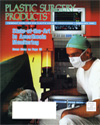3-D CAD/CAM Facilitated Custom Silicone Implants for Facial Contouring
by William J. Binder, M.D., F.A.C.S.
Plastic Surgery Products- February 1993
The correction of facial contour defects has always posed a challenge to the reconstructive surgeon. Traditionally, severe deformities have been successfully treated with orthognathic surgical approaches, including osteomies and bone grafting. However, the use of orthognathic surgery for the defects with our functional impairment requires a relatively large surgical procedure with its attendant complications and usually expansive hospitalization. Carving and modifying autogenous bone or cartilage grafts of many specific facial contour defects, particularly post-traumatic deformities, may be equally unsatisfactory do to their failure to conform precisely to the underlying surfacing.
Advances in the areas of computer imaging and computer-aided design/ computer-aided manufacture (CAD/ CAM) have recently enabled the production of custom alloplastic implants which solve many of the problems associated with the correction of most contour defects. The process begins with a computerized topographic (CT) scan of the anatomical area encompassing the defect. Appropriate scanning protocols have been developed which permit complete CT assessment of a facial defect with minimal radiation exposure. Next, the CT scan data is reformatted into a three dimensional (3-D) computer image linked to a CAD / (3/D) computer image linked to a CAD/CAM milling machine, which in turn produces a 3-D physical model of the anatomical area scanned. The resulting life-size anatomical model is then used as a template from which an extremely precise silicone implant can be cast.
The computerized process eliminates the need for invasive bone impression surgery or indirect, external facial moulage methods that use the outer surface of the skin and do not accurately reflect the body skeletal structure underneath. Moulage-derived implants fail to conform to the contours of the defect site, and cannot produce a stable implant. However the posterior surface of an implant designed utilizing the computerized 3-D process and anatomical model is able to fit the skeletal defect exactly. This facilitates corrected implant placement and implant stability. The custom implants conform to irregular bony surfaces so precisely that they usually require no internal or external means of fixation.
Custom implants can also be used to treat soft tissue deformities. By configuring the implant with extended anterior dimensions that approximate the volume of normal soft tissue contour, the implants can also replace deficient volume and simulate soft tissue contour, the implants can also replace deficient volume and simulate soft tissue replacement.
CAD / CAM facilitated custom implants are commercially produced and fabricated from medical grade silicone elastomer. At this time, silicone rubber is the biomaterial that possesses the characteristics that best satisfies all of the requirements necessary for this process to manufacture customized implants.
Each year, comprehensive health care continues to become more difficult to obtain and facial disfigurement is often excluded from coverage as a “pre-existing” condition. In the majority of cases, the insertion of custom implants can be performed on a more cost-effective outpatient basis requiring less-operative time.
The application of computer technology to assist in the production of custom onlay implants provides the reconstructive surgeon with a new, more accurate means of correcting facial contour defects.
Note: Used with Permission of PSP, an Ascend Media Publication,www.psp-interactive.com.

